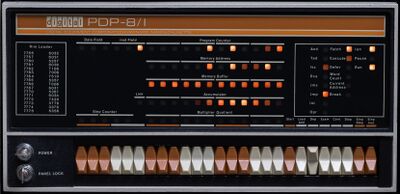PDP-8/I
From Computer History Wiki
| PDP-8/I | |
 PDP-8/I front panel | |
| Year Introduced: | 1968 |
|---|---|
| Form Factor: | minicomputer |
| Word Size: | 12 |
| Logic Type: | TTL |
| Design Type: | clocked random logic |
| Clock Speed: | 333KHz |
| Memory Speed: | 1.5 μseconds |
| Physical Address Size: | 32KW (requires optional MC8/I) |
| Virtual Address Size: | 4KW |
| Memory Management: | bank selection, CPU mode |
| Bus Architecture: | negative I/O bus |
| Operating System: | TSS/8. Disk Monitor System |
| Predecessor(s): | PDP-8 |
| Successor(s): | PDP-8/E |
The PDP-8/I was introduced in 1968 as the successor to the PDP-8. It was constructed out of TTL ICs on M-class FLIP CHIPs; the first DEC computer to be built using ICs.
Options included:
- KA8/IB Positive I/O Bus Interface, to allow use of newer PDP-8 devices
- MC8/I Memory Extension Control, which was needed to support more than 4K words of memory
- MP8/I Memory Parity
- KE8/I Extended Arithmetic Element, which supported hardware integer multiplication and division, one-bit double-word shifts, and normalization
- KT8/I Time Sharing Hardware Modification, which allowed the computer to operate in either Executive Mode or User Mode
It could perform an addition to the accumulator in 3.0 μseconds, and a 12 by 12 bit multiplication with 24 bit result in 6.0 μseconds, using the math extension hardware.
Images
| v • d • e PDP-8 Computers, Software and Peripherals |
|---|
| PDP-8s: PDP-5 • PDP-8 • LINC-8 • PDP-8/S • PDP-8/I • PDP-8/L • PDP-12 • PDP-8/E • PDP-8/F • PDP-8/M • PDP-8/A
Workstations: VT78 Also: PDP-8 family • PDP-8 architecture • PDP-8 Memory Extension units |
